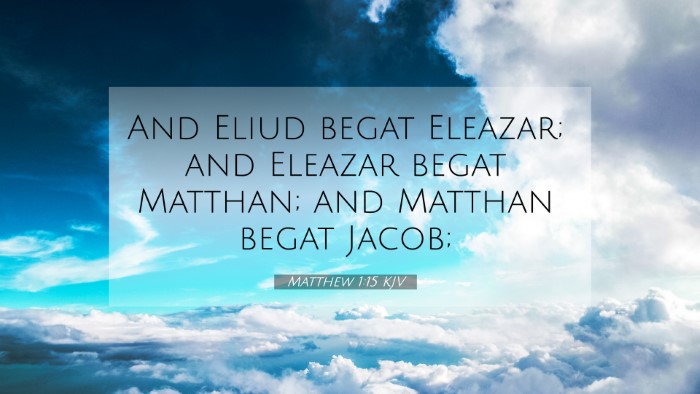Understanding Matthew 1:15
Verse: Matthew 1:15 - "And Eliud begat Eleazar; and Eleazar begat Matthan; and Matthan begat Jacob."
This verse is part of the genealogy of Jesus Christ, specifically detailing the lineage from David to Joseph, the husband of Mary. Each name represents a key figure in the storied heritage that connects the Old Testament to the New Testament.
Significance of Matthew 1:15
The genealogy in Matthew serves multiple purposes, including affirming Jesus' rightful place within the Jewish tradition and establishing His fulfillment of Old Testament prophecies concerning the Messiah.
Insights from Public Domain Commentaries
-
Matthew Henry: Matthew Henry highlights the importance of lineages in biblical contexts, signifying God’s sovereignty across generations. This verse showcases God's faithfulness to His promises throughout history, reinforcing the notion that Jesus is the culmination of God’s redemptive plan.
-
Albert Barnes: Albert Barnes comments on the notion that these names, while seemingly obscure, each played a vital role in the unfolding story of redemption. He emphasizes that every inclusion in this genealogy serves to knit together God’s purposes and illustrate the continuity of His covenant.
-
Adam Clarke: Adam Clarke elaborates on the names listed, indicating their historical significance. He suggests that this genealogy not only legitimizes Christ's earthly lineage but also serves to connect with prophecies found in the Hebrew Scriptures, confirming Jesus' messianic identity.
Cross-Referencing Biblical Texts
Matthew 1:15 has multiple cross-references that enhance our understanding of its significance
-
1 Chronicles 3:10-16: This passage provides a comprehensive lineage of David's descendants, noting the kings that followed through David's line, including those leading to Joseph.
-
Luke 3:24-38: Luke’s genealogy diverts earlier, providing a different lineage down to Jesus, which highlights a contrasting perspective on Jesus' heritage and the divine inclusiveness of His mission.
-
Isaiah 11:1: This prophecy speaks of a shoot coming from the stump of Jesse (David's father), linking back to the royal lineage that culminates in Jesus.
-
Jeremiah 23:5: Jeremiah confirms the coming of a righteous branch from David, affirming the messianic lineage and its significance in Jewish prophecy.
-
Matthew 2:1: The birth narrative of Jesus further cements His royal heritage, stemming from the genealogy laid out in Matthew 1.
-
Revelation 5:5: Alluding to Jesus as the Lion of the tribe of Judah emphasizes the strength and royal connection back to David, affirming His qualifications as Messiah.
-
Matthew 22:42-45: Jesus confronts the Pharisees about His identity and lineage, reinforcing the importance of understanding His origins from both human and divine perspectives.
Connections Between Bible Verses
The genealogical links found in Matthew 1:15 establish a strong foundation for understanding major biblical themes and prophetic connections:
-
Thematic Connections: The concept of lineage and genealogy plays a key role in understanding God’s faithfulness across generations, showcasing how God preserved His promises through history.
-
Shared Themes: Each name in Matthew 1:15 represents not only a biological connection but also relates to broader themes of covenant, redemption, and prophecy.
-
Inter-Biblical Dialogue: The dialogue between the Old and New Testaments is evident in how the genealogies provide a thread of continuity, linking the promises made to Abraham, David, and the prophets with their ultimate fulfillment in Christ.
Tools for Bible Cross-Referencing
For those looking to explore the intricacies of cross-references, there are many tools available:
- Bible Concordance: A comprehensive resource to help find connections and themes within the scripture.
- Bible Cross-Reference Guide: Reference materials that offer insights into how different verses relate thematically.
- Bible Chain References: Helpful in tracing theological themes through different books of the Bible.
Conclusion
Matthew 1:15 is not just a genealogical marker; it is a critical part of the narrative that connects the Old Testament promises with the New Testament fulfillment in Christ. By understanding this verse within its broader scriptural context, one can appreciate the thematic connections and the significance of the lineage that brings forth the Messiah.
In studying the connections between Bible verses, we recognize that each passage contributes to the greater narrative of faith, redemption, and God’s unwavering love for humanity.


